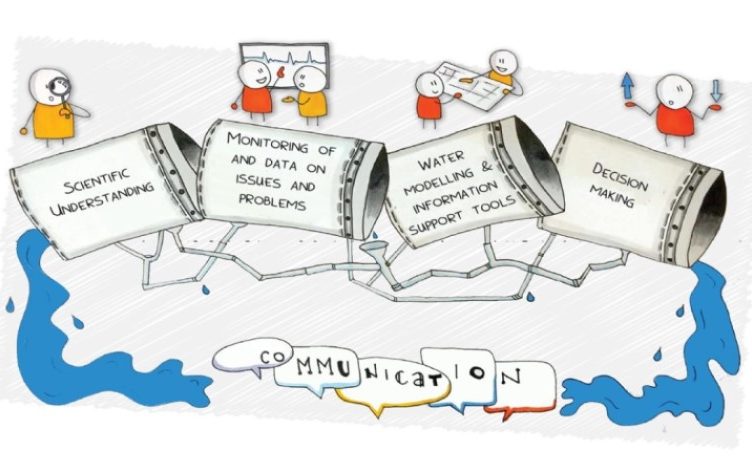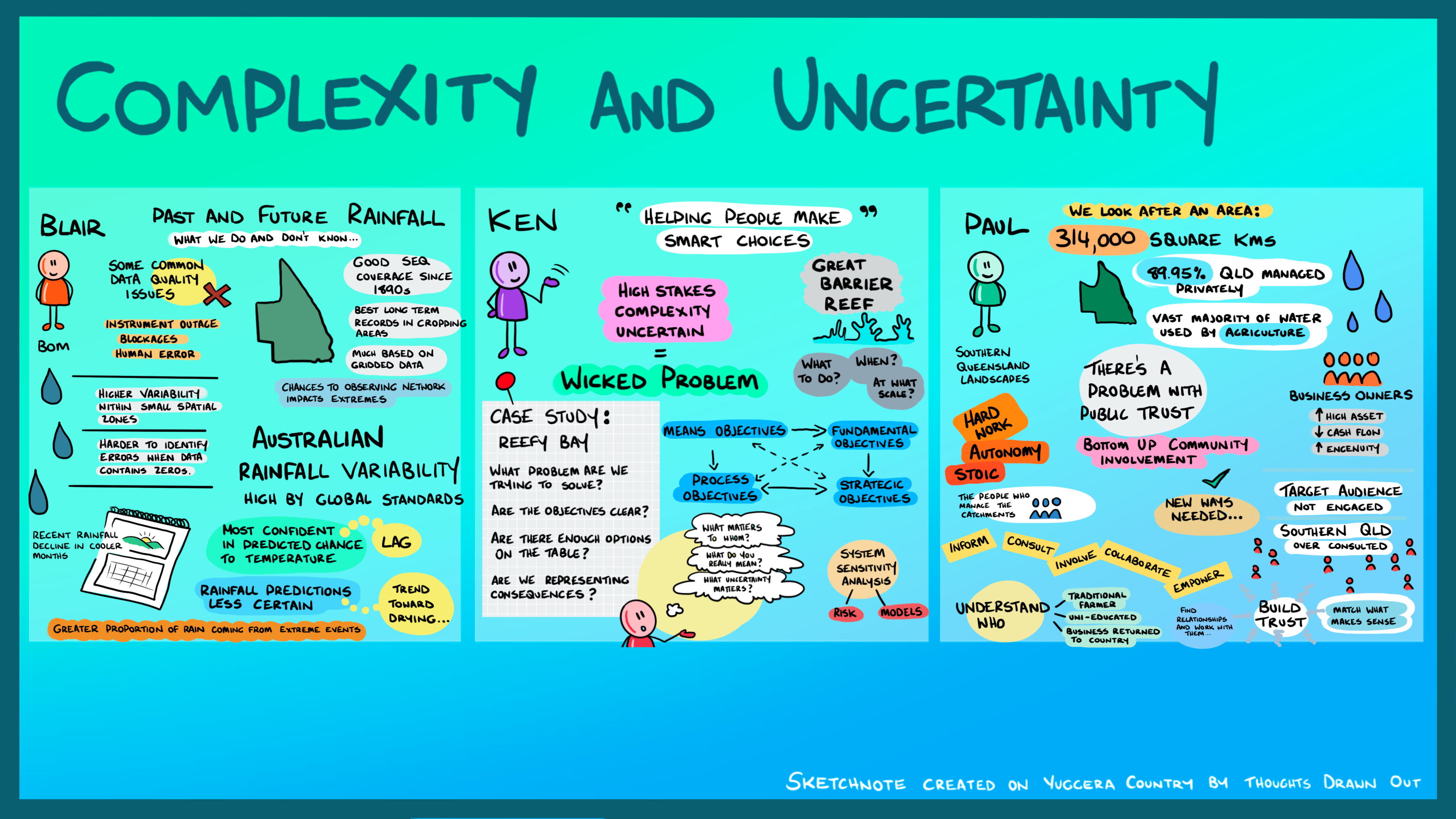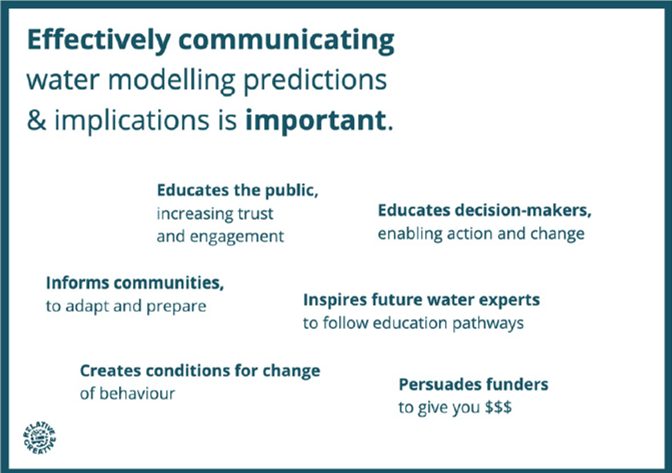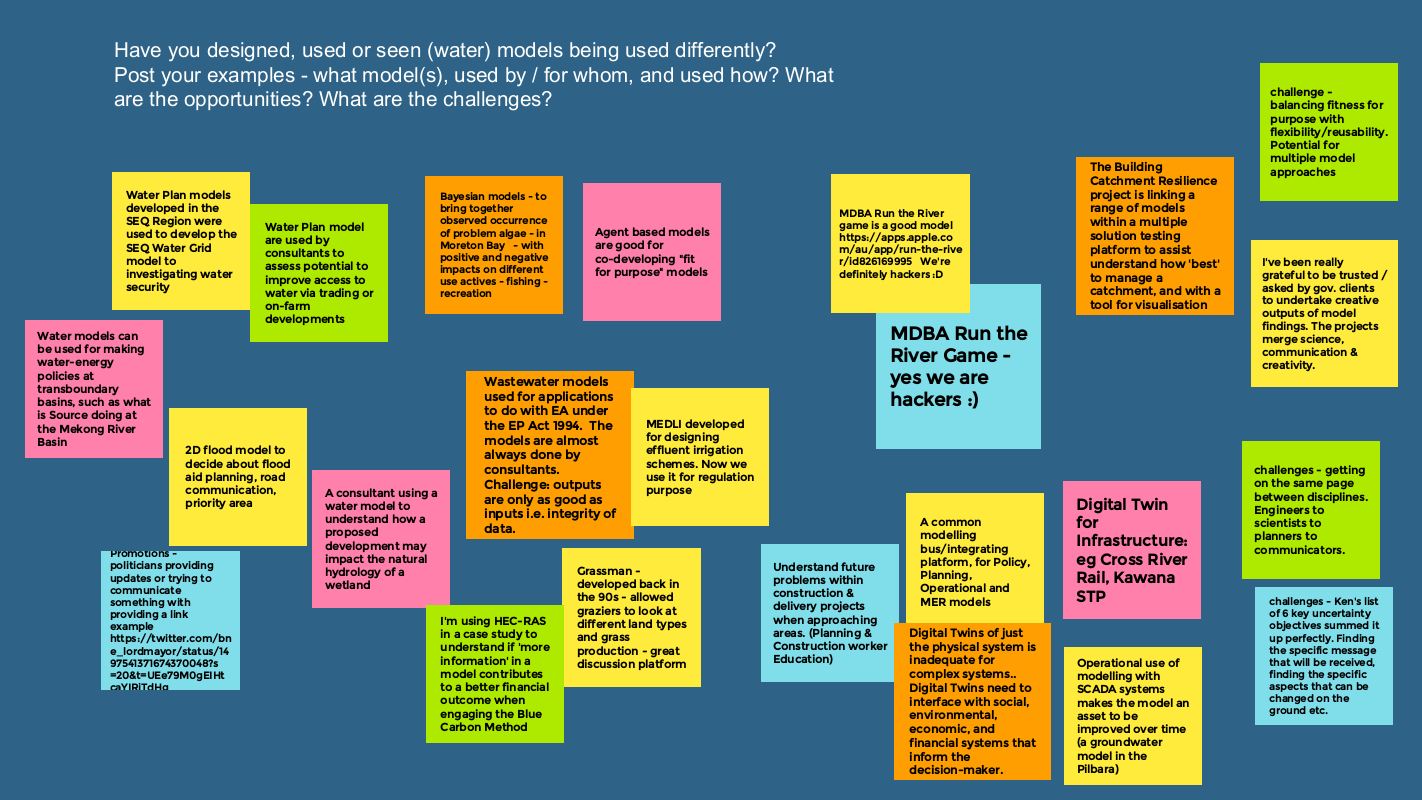
05/12/2024
Event Summary: Overview of water quality modelling projects from the Queensland Water Modelling Network with Callym Dunleavy
Read more
Over the past few years, the Queensland Water Modelling Network (QWMN) Capability, Collaboration and Capacity Program (3CP), have been expanding our reach to our broader community, extending the collective’s offerings to our regional, interstate and global network. We have established a reputation for doing things a bit differently and the first instalment of the 2022 QWMN Forum event did not disappoint. Offering an opportunity for connection between otherwise, disconnected colleagues whilst presenting a cohesion of topics that underpin the scope of the broader QWMN RD&I Strategy.
On Tuesday 14 June, the QWMN 3CP team, and a brilliant collective of presenters, were joined by participants from various local, state and national departments and agencies, Natural Resource Management groups, consultants, academics, higher degree research students and water utility colleagues, for a day of presentations, interactive workshops and genuine, online engagement. The day was divided into four parts, exploring:
After Piet Filet’s welcome to this online event, Mark Jacobs, Deputy Director-General, Science and Technology, Department of Environment and Science opened the forum, highlighting the importance of connection between network members and the resultant capability and capacity building, sector wide. Mark acknowledged the role the network plays in developing impact at the local, regional and global level.
Throughout the online forum sessions, Hayley Langsdorf, Chief Doodler at Thoughts Drawn Out, recorded presentations and discussion between participants to create the illustrations you will find below. We also actively recorded highlights from the chat thread which you will also find in each session block. For details of images and links to presentations and recordings in this article, please hover your cursor over the purple text to select.

For the first session of the day, Georgine Roodenrys, Partner at Deloitte, shared her insights on the challenges we collectively face in bringing about an “extraordinary” transition by 2030 and underpinning environmental, social and governance (ESG) components versus sustainability.
With decision makers overwhelmed by future uncertainty and the cost of action, Deloitte estimate a $3.5 trillion loss to the Australian economy, in the predicted warmer world. However, it’s not all doom and gloom; agile thinking is emerging as a strength among Australian based firms, support is arising in economists, and consumers are in the drivers seat.
In a new economic climate, based on solutions and significant transformation, there is potential for a $890 billion gain to our economy. This is the time for a “renaissance in applied science.” As we shift our focus from the “take-make-waste” linear economy to a circular economy, opportunities are presenting themselves. The key challenge for science is we can no longer afford to be single focussed. It’s time to think systemically and come together to create change.
Ryan Turner, Program Lead of the Reef Catchments Science Partnership (UQ and DES) was up next, sharing an inspired presentation on Decision Making – Seeking Underpinning Evidence. Focussing in on effective science communication and the struggles we confront converting information into knowledge. Knowledge is shared when we “tell a compelling and accurate story about the insights we have uncovered”, without hiding the complexity. When we share our science through clear and concise information, we educate others and create opportunities for real change.
To build trust and relationships, science needs to become more integrated, applying a holistic and consistent approach. Plus look at tangible evaluation that enables ongoing feedback between models and monitoring. Ryan provided a real-world example of the outcomes of collaborative knowledge building in a grower-led water quality monitoring program in Sandy Creek, Plane Basin. Following poor results in the Healthy Rivers to Reef report card, landholders became interested in bringing down pesticide concentrations and approached local authorities and industries. By providing landholders ownership of a monitoring program, there has been an increase in trust, knowledge was built through education, a co-designed program was developed, and the ecosystem is recovering.
Highlights from participant chat
Ryan – Decision making: seeking underpinning evidence
CLICK HERE Use Passcode: q07Rm!RB

Session two was opened by Blair Trewin, Climate Scientist with the Bureau of Meteorology (BoM), who walked us through some of the complexity and uncertainty of weather data. Australian rainfall variability is unusually high by global standards and is mostly based on gridded data. This data can be readily impacted by coverage, type of data available for a given location and imperfections in data collection or instrument outages.
It’s important to note that when modelling with this data, which timespan is being selected as it can cause significant contrasts in the forecasts. Trends suggest a recent decline in Australia’s rainfall during the cooler months though, sub-daily timescales show an increase in heavy precipitation. Many parts of the world are observing increases in extreme daily rainfall, though this is not the case for most of Australia.
We have the most confidence in temperature projections with temperatures expected to warm by 0.4 – 1.3 degrees Celsius by 2030. Changes in rainfall are more uncertain, but indications suggest an increase of 5-10 percent for one in twenty-year wettest day. The mean rainfall in eastern Queensland is trending towards a drier climate with the greatest proportion of rain coming from extreme events.
Ken Anthony, Managing Director and Environmental Strategies ES5, joined us to share from his broad range of experience dealing with uncertainty in the water sector. We all make decisions routinely, but when confronted with high stakes, complexity and uncertainty, we find ourselves in the midst of a wicked problem. Ken’s presentation walked us through a constructed example of a wicked problem, based on the challenges involved in the Reef Restoration and Adaptation Program (RRAP) for the Great Barrier Reef. The decision problem in this example was – “Should the Reefy Shire Council invest $3M per year over 10 years to improve the water quality of Reefy Bay?” and Ken posed some of the issues that arise around framing of the problem, clarity of objectives, the options considered, and whether representation of the consequences is comprehensive.
When approaching a wicked problem as a decision maker, there are six key dimensions of uncertainty:
Ken shared the framework RRAP use to illustrate the “information supply chain” between various reef processes – drivers > ecological variables > supporting functions > ecosystem services > values. Using this structure, we are presented with an opportunity to minimise the risk of bafflement by identifying reducible uncertainties, such as opportunities for closing knowledge gaps with data, modelling and sharing, to enable quality decisions.
Our final presenter in this session was Paul McDonald, CEO of Southern Queensland Landscapes (SQL) who shared from his experience working on the ground with key partners on How to enliven grass roots involvement – a Southern Queensland experience. SQL as a Regional Natural Resource Management group operate across an area of 314 000 square kilometres, or 1.3 times the area of Victoria. Paul opened his presentation by acknowledging just how much his team have and continue to learn from the 28 Traditional Owner Nations in their region. As SQL work toward their vision of “Flourishing Landscapes”, they regularly face difficulties stemming from a lack of trust by landholders in various authority groups, which is an unfortunate mismatch as nearly 90% of Queensland is managed by these landholders.
“Trust requires a relationship.”
As we collectively seek to gain trust with, and develop a meaningful pathway alongside landholders, knowing who we are dealing with and what matters to them, is essential to outcomes. Front and centre to SQL community engagement is a practical approach that puts land managers at the centre of their learning, respecting what they care about, and often giving attention to issues not directly related to project outcomes.
Paul and his team have developed the graphic below, to illustrate a pathway of actions towards Flourishing Landscapes, Healthy Communities, based on a foundation of trust, respect and attachment to landscape. You can learn more about the SQL approach to community engagement on the resources page of their website – https://www.sqlandscapes.org.au/resources
Highlights from participant chat
Blair – Dealing with complexity and uncertainty of weather data
Ken – Dealing with Uncertainty in the water sector
Paul – Achieving acceptability with on ground partners
CLICK HERE Use Passcode: q07Rm!RB
The third session for the day drew our attention towards how to effectively communicate our science. This interactive workshop, lead by Bec Barnett, Co-Director at Relative Creative, presented participants with a “rapid and playful”, team-based challenge to design a communication strategy. Using a Miro® workspace, participants formed small groups and were asked to step through six key communication elements, considering key aspects of each – topic, audience, media, information, style and pitch.

The workshop provided participants an opportunity to work together to explore a method for building deeper understanding between communicators and the audience, alongside concepts to create trust and enable action for change. As can be seen in the workshop workings, the audience can be diverse for our modelling topics and how they are best engaged can be tailor made with the right mix of content and style. It was great to see the different approaches employed by groups in the example.
Bec Barnett – QWMN Communications workshop
The final session for the day was led by Abel Immaraj, National Water Resource Systems Leader at Aurecon and Amir Hedjripour, Techinical Director of Hydrology and Hydraulics at RPS, on the role of gamification through the lens of a Southeast Queensland Sediment and Nutrient Trading Scheme called Aroona. Sponsored by the Department of Environment and Science (DES) QWMN RD&I program and a consortium of partners and supporters, Abel and Amir are exploring the effective use of a market trading game to view market instruments that catalyse real change in a cost effective manner. With a value proposition of environmental, social/cultural, economic and foundational improvement, they have developed a trading scheme for a digital twin of sediment and nutrients for SEQ, in the form of a Monopoly game.
Played by four players, with the shared objectives of improving catchment health, and meeting urban and economic challenges in a green economy, the game provides insights as to how a trading scheme like this might operate in the real world.

The final presentation for the day was led by Joseph Guillaume, Research Fellow, at Australian National University (ANU) and Wendy Merritt, Research Fellow, (ANU) on the benefits and learning opportunities presented by a digital twin platform. The primary purpose of this digital twin is to provide a place for accumulating information, identify uncertainty and gaps and provide reason about the value of new information and improvements.
Joseph and Wendy provided their example for the Gilbert River catchment which intends to improve understanding and local engagement in water governance. A broad range of activities have been undertaken in the Gilbert River agricultural precinct including on ground landholder visits and interviews, engagement with state government, integration of public data and construction of the digital twin platform. Along the way, Wendy and Joseph have found the digital twin has facilitated improved conversations, in turn improving information and knowledge sharing among government, NRM groups, Traditional Owners and landholders.
The platform provides a foundation for knowledge accumulation and the progressive improvement of system understanding and modelling. It provides for explicit management of local knowledge, positions NRM groups with a view of what can be achieved and a space to discuss what’s happening on the ground without constraints. Trough targeted monitoring and facilitated community prioritisation and participation, the people are being empowered with their own knowledge management system for a total system understanding.
Highlights from participant chat
Abel and Amir: The role of gamification
Wendy and Joseph: Benefits of a digital twin
CLICK HERE Use Passcode: q07Rm!RB
To close the day, Brian McIntosh, Director of 3CP at QWMN, led a Jamboard discussion around how models are being used differently and the kinds of opportunities and challenges faced as we dance between determining the wants and needs of people and providing the right functionality to enable the use of technology to suit their needs. The discussion highlighted a number of model types and their uses and the kinds of challenges professionals face when approaching decision making conversations.

The current challenges we confront might seem impossible to face alone, but through working across disciplines, we can share in this complexity, learn from each other’s real world experiences and utilise technological advancements to move forward. Solutions to new and wicked problems will only present themselves when we begin to do things differently.
Brian, Piet and Sarah would like to thank all who participated and contributed to this full day of collaboration, knowledge sharing, learning and innovation and trust this information will serve to continue our collective development towards a thriving land, people and economy.